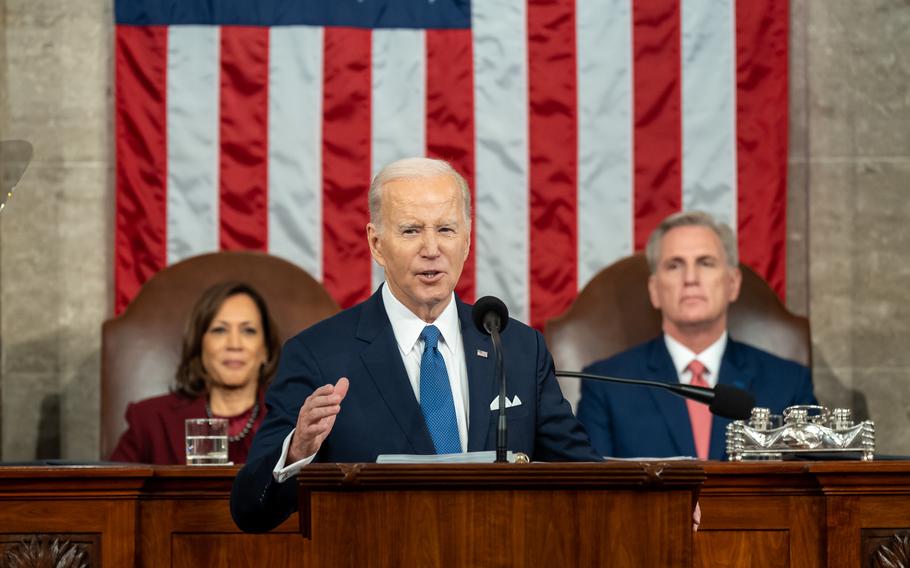
President Joe Biden delivers the State of the Union in Washington, D.C., Tuesday, Feb. 7, 2023, with Vice President Kamala Harris and House Speaker Kevin McCarthy behind him. (White House)
The clash between President Joe Biden and House Speaker Kevin McCarthy over U.S. fiscal policy is set to intensify after the Congressional Budget Office warned of a sharp deterioration in the federal budget.
“Over the long term, our projections suggest that changes in fiscal policy must be made to address the rising costs of interest and mitigate other adverse consequences of high and rising debt,” CBO Director Phillip Swagel said in a statement.
Among the stark figures released by the CBO Wednesday: the budget deficit for 2023 is now seen $426 billion worse than projected last May, at $1.41 trillion. Debt held by the public is seen climbing to $46 trillion by 2033, amounting to 118% of GDP — the highest in U.S. history.
The CBO report is the yardstick by which all federal legislation will be measured this year, including debt-ceiling related proposals and Republican plans to put the budget on a path to balancing in 10 years. The two parties have already traded barbs over who’s to blame for the rising debt burden, and how to address it.
“Today’s report from the non-partisan CBO shows the damage of Democrat spending on the national debt is worse than we thought,” said House Budget Chairman Jodey Arrington, a Texas Republican. “House Republicans must rein in the unbridled spending and restore fiscal sanity in Washington before it’s too late.”
Biden, meantime, has called on Republicans to reveal their spending-cut demands before proceeding with further talks with McCarthy on addressing the deficit. Senate Majority Leader Chuck Schumer said Wednesday, “I don’t think Speaker McCarthy will be able to unify his conference.”
Democrats have also pointed to revenue losses due to former President Donald Trump’s tax cuts and the GOP’s plans to extend them further. The CBO assumes that the Trump individual tax cuts expire as currently scheduled in 2026, which would have the effect of boosting revenue.
The CBO also estimated Wednesday that the $31.4 trillion debt ceiling will need to be raised sometime between July and September, by which time the Treasury Department will be facing the risk of a payment default.
The Treasury since last month has been deploying accounting maneuvers to stay within the limit and still meet federal obligations, buying itself some time for now.
Wednesday’s estimates show the debt subject to the limit soaring to $52 trillion by 2033, after the government runs a cumulative budget shortfall of $20.3 trillion over the decade. By 2033, the U.S. will be running a deficit amounting to 7.3% of gross domestic product, against 5.4% for this year.
Republicans have demanded that Biden and congressional Democrats agree to steep spending cuts to restore U.S. fiscal health, in return for voting to raise the federal debt limit. Although Biden says he is not negotiating over the debt ceiling, any separate-track deal with McCarthy on deficits could ease the way for a bill boosting or suspending the debt ceiling in the House.
As for the economy, the CBO’s latest figures suggest a sharp deterioration this year, with just 0.1% real GDP growth and a jump in the unemployment rate to 5.1%. Last month, the jobless rate hit a half-century low of 3.4%.
Inflation, measured by the personal consumption expenditures price index, is seen at 3.3% this year and 2.4% in 2024 — still above the Federal Reserve’s 2% target.
The CBO’s new estimates showcase a sharp deterioration in the U.S. fiscal picture, even after Biden and Democrats highlighted deficit-reducing elements in their signature Inflation Reduction Act, passed last summer. Those measures included a new minimum corporate tax and an enlarged budget for the Internal Revenue Service aimed at combating cheating.
The larger deficits compared with last May were affected by newly legislated spending — especially for veterans benefits — as well as enlarged spending tied to faster inflation and higher interest rates.
The top challenge for both parties in reducing the deficit are overhauling the Social Security and Medicare programs, which are the biggest drivers of increasing spending due to an aging population. Social Security old-age spending and Medicare both roughly double from last year to about $2 trillion annually by 2033.
But leaders in both parties are now moving to exclude these entitlement programs from budget talks, due to political sensitivities of benefit cuts or payroll tax increases.
Now that the congressional referee has set the parameters for the budget, it will be up to both sides to show their plans.
Biden plans to release his budget proposal — based on separate, White House economic estimates — on March 9.
“You’ll see that my budget will invest in America, lower costs and protect and strengthen Social Security and Medicare, while cutting the deficit by $2 trillion over 10 years,” Biden said on Wednesday.
House Republicans plan to vote on their own budget by April 15, but may struggle to muster the 218 votes needed to adopt it. The ambitions of the most-conservative members to reach a balanced budget may come up against nervousness by moderates about the level of spending cuts required.
Read More: Republicans’ Balanced-Budget Aim Clashes With Fiscal Realities
If entitlements, defense and veterans spending are off the table, then much of the annual non-defense discretionary budget would need to be virtually eliminated. That category includes both unpopular programs like foreign and humanitarian aid as well as more popular items like the National Parks, cancer research and border security.
The GOP has proposed to start with a $150 billion cut to non-defense discretionary spending in the fiscal 2024 appropriations bills, reversing increases approved in last year’s omnibus spending package for the current fiscal year.